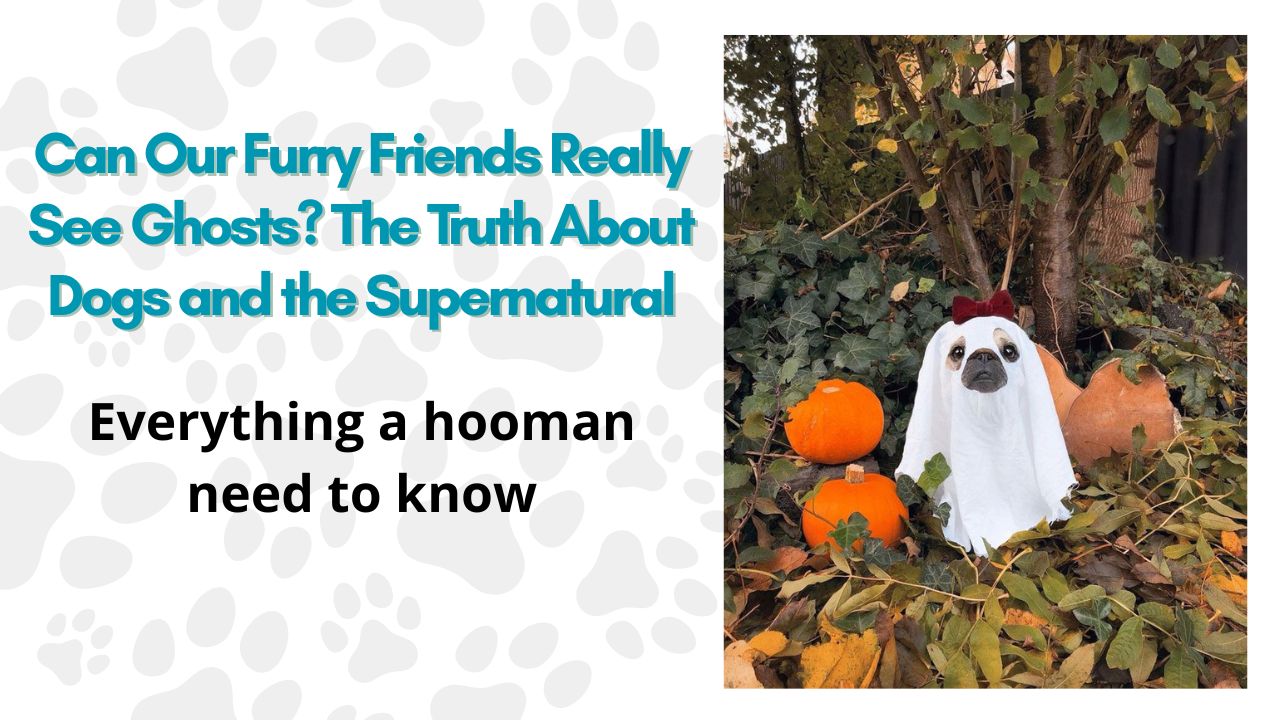Have you ever caught your dog staring intensely at what seems like empty space? Maybe they’ve started barking at nothing visible, or perhaps they’ve suddenly become anxious in a particular corner of your home. If you’re like most dog owners, you’ve probably wondered: can dogs see ghosts? This age-old question has fascinated humans for centuries, and today we’re diving deep into the mysterious world of canine perception to uncover the truth.
Introduction

Let’s start with the basics – understanding exactly what our four-legged companions can actually see. Dogs experience the world quite differently from us humans, and their visual capabilities are both fascinating and unique.
Dogs typically have 20/75 vision, which means they must be 20 feet from an object to see it as clearly as a human standing 75 feet away. While this might sound like poor eyesight, don’t feel sorry for your pup just yet! Their eyes are perfectly designed for their needs as descendants of nocturnal hunters.
The structure of a dog’s eye tells us everything we need to know about their visual superpowers. Their retinas are rod-dominated, which gives them incredible advantages in low-light conditions. Think of rods as the night-vision specialists, while cones handle color perception and fine details. Dogs have significantly more rods than humans, making them excellent at detecting movement and seeing in the dark.
What’s truly remarkable is their motion detection abilities. Dogs can spot moving objects much more quickly and accurately than we can, thanks to something called the critical flicker fusion rate. While humans perceive a light as steady when it flickers 60 times per second, dogs need that same light to flicker about 75 times per second to fool them. This means they’re incredibly sensitive to even the slightest movements that we might completely miss.
Their eyes also contain a special reflective layer called the tapetum lucidum, which acts like a mirror behind the retina, bouncing light back and giving them that distinctive glow in the dark. This adaptation enhances their night vision significantly, making them natural-born guardians of the night.
Can Dogs See Ghosts? True or Myth?
Now for the million-dollar question that’s been keeping dog owners awake at night: can dogs actually see ghosts? The honest answer might surprise you – we simply don’t know for certain.
There is no definitive scientific proof that dogs can see ghosts, primarily because there’s no scientific consensus that ghosts exist in the first place. However, this doesn’t mean we should dismiss the possibility entirely. As Russell Hartstein, a certified dog behavior consultant, puts it: “The most interesting part of the science of dog behavior and understanding is that we simply don’t know so much”.
The enigmatic nature of animal behavior leaves room for the possibility that dogs may perceive things beyond human comprehension. Many pet owners have compelling stories about their dogs reacting to seemingly invisible presences, and these experiences shouldn’t be brushed aside lightly.
Dr. Mary Burch, a certified animal behaviorist and director of the AKC Family Dog Program, suggests that an individual’s own beliefs in the paranormal correlate to the belief in their dogs seeing ghosts. This doesn’t invalidate the experiences – it simply means our interpretation of our dog’s behavior is influenced by our own worldview.
What we do know is that dogs possess sensory abilities that far exceed our own. Their world is filled with sounds, smells, and visual cues that are completely invisible to us. So when your dog suddenly stops and stares at an empty hallway, they might indeed be perceiving something – just not necessarily something supernatural.
The scientific consensus remains uncertain, but the possibility isn’t entirely ruled out. After all, if ghosts do exist and prefer appearing in darkness, dogs would have a distinct advantage over humans in perceiving them, given their superior night vision and motion detection abilities.
Dog’s Vision Power and What Colors They Can See
Let’s dive deeper into the fascinating world of canine color perception. For decades, people believed that dogs only see in black and white, but modern research has completely debunked this myth.
Dogs are dichromatic, meaning they have two types of color-detecting cones in their eyes, compared to humans who are trichromatic with three types. This doesn’t mean they live in a dull, colorless world – it just means their color palette is different from ours.
Dogs can see blue and yellow hues quite well, but they struggle with red and green. To put this in perspective, while humans can distinguish between 7 to 10 million colors, dogs have a more limited but still vibrant palette. They see the world somewhat like a person with red-green color blindness would.
Here’s what this means in practical terms:
- Red objects appear brownish or grayish to dogs
- Green grass might look yellowish
- Blue and yellow objects stand out brilliantly
- Purple might appear blue
But here’s where it gets interesting for our ghost discussion: dogs excel at detecting movement, particularly in low light conditions. Their superior night vision, combined with their ability to detect subtle movements, means they can spot things in the dark that would be completely invisible to us.
Dogs have better peripheral vision than humans, allowing them to see more of the world around them simultaneously. However, they don’t judge distance quite as well as we do, which is why they might sometimes seem to be staring at “nothing” when they’re actually focusing on something at a distance we can’t perceive.
Their visual acuity might be lower than ours, but their eyes are perfectly adapted for their evolutionary needs. As descendants of nocturnal hunters, they needed to excel at spotting moving prey in low light conditions rather than reading fine print or distinguishing between subtle color variations.
Behavioral Studies of Dogs Who Eat Papaya
Now, you might be wondering what papaya has to do with dogs seeing ghosts – and that’s a fair question! While there’s no direct connection between papaya consumption and supernatural perception, understanding how different foods affect dog behavior can help us better interpret their actions.
Papaya is generally safe for dogs in moderation and can actually provide some interesting behavioral benefits. The fruit contains natural digestive enzymes, particularly papain, which aids in breaking down proteins and can be especially helpful for dogs with sensitive stomachs.
Dogs who regularly consume small amounts of papaya often show:
- Improved digestive health due to the fruit’s fiber content
- Better nutrient absorption from the vitamins A, C, and E
- Enhanced immune system function
- More stable energy levels throughout the day
However, it’s crucial to note that papaya seeds, skin, and leaves contain compounds that can be toxic to dogs. Unripe papaya contains higher levels of papain, which can cause stomach upset, while the seeds contain small amounts of cyanide and pose a choking hazard.
Interestingly, dogs with better overall health and nutrition tend to have more stable behavior patterns. A well-nourished dog is less likely to exhibit erratic behaviors that might be mistaken for supernatural encounters. When dogs are feeling unwell or experiencing digestive issues, they might display unusual behaviors like staring at walls or acting anxious in certain areas.
The key takeaway here is that proper nutrition supports optimal brain function and sensory perception. A healthy dog with a balanced diet is more likely to have reliable sensory experiences, making it easier for us to distinguish between normal behavioral responses and potentially unusual phenomena.
Can Dogs Sense Ghosts?
This is where things get really interesting. While we can’t definitively say dogs can see ghosts, the question of whether they can sense them opens up a whole new realm of possibilities.
Dogs possess what many experts call a “sixth sense” – similar to human intuition but much more developed. Unlike humans, who tend to rationalize away their gut feelings, dogs are more inclined to trust their instincts and act upon them immediately.
Let’s break down the sensory advantages that might allow dogs to detect supernatural presences:
Enhanced Hearing Capabilities: Dogs can hear frequencies ranging from 40 Hz to 60,000 Hz, while humans typically hear between 20 Hz and 20,000 Hz. They can detect sounds at distances four times greater than humans and have the remarkable ability to focus on specific sounds while blocking out others. If ghosts communicate through sound frequencies outside our hearing range, dogs would be the first to know.
Extraordinary Sense of Smell: Dogs’ olfactory abilities are 10,000 to 100,000 times more sensitive than humans. They can smell pheromones and detect chemical changes in the environment that are completely imperceptible to us. Some experts suggest this could be considered a form of “ESP” – extra smell perception.
Superior Motion Detection: As we discussed earlier, dogs excel at spotting even the slightest movements, especially in low light conditions. If supernatural entities manifest as subtle movements or energy shifts, dogs would have a significant advantage in detecting them.
Sensitivity to Electromagnetic Fields: While not extensively studied, some researchers suggest that dogs might be sensitive to electromagnetic field changes, which some paranormal investigators associate with ghostly activity.
Vibrational Awareness: Dogs can sense movement and vibration through their super-sensitive whiskers (vibrissae), which can detect the slightest air movements and send detailed information to their brains about their environment.
The fascinating thing is that dogs are more likely to act on these sensory inputs without the mental filters that humans apply. When we sense something unusual, we often rationalize it away. Dogs, on the other hand, trust their instincts completely.
Questions Related to Dogs Seeing Ghosts: 7 Common Concerns Answered
1. Why does my dog suddenly start barking at empty corners or hallways?
This is one of the most common experiences reported by dog owners. Dogs might be reacting to sounds, smells, or movements that are completely imperceptible to humans. Their superior hearing allows them to detect high-frequency sounds from much farther distances, so they might be responding to something as mundane as a mouse in the walls or a neighbor’s activity several houses away.
However, some dogs may exhibit behaviors that make it look like they’re sensing an apparition nearby. The key is to observe the pattern – if your dog consistently reacts to the same spot, it might be worth investigating for practical causes like drafts, settling sounds, or even their own reflection in a window.
2. Can puppies see ghosts better than adult dogs?
There’s no scientific evidence suggesting that puppies have enhanced supernatural perception compared to adult dogs. However, puppies are generally more reactive to their environment as they’re still learning to interpret sensory information. Young dogs might be more likely to react strongly to unfamiliar sounds, smells, or sights that adult dogs have learned to ignore.
Puppies also have developing nervous systems and might be more sensitive to environmental changes. What might appear as supernatural sensitivity could actually be a normal part of their learning process as they figure out what deserves attention and what doesn’t.
3. Do certain dog breeds see ghosts more than others?
While there’s no scientific evidence that specific breeds have enhanced ghost-detecting abilities, some breeds do have superior sensory capabilities that might make them more likely to react to unusual phenomena. Breeds developed for hunting, guarding, or tracking often have more acute senses.
For example, hounds have exceptional scenting abilities, while sight hounds excel at detecting movement. Herding breeds are often highly alert to environmental changes. These enhanced sensory capabilities might make them more likely to notice and react to subtle environmental changes that other dogs might miss.
4. Should I be worried if my dog seems to see ghosts?
The first step is always to rule out medical causes. Sudden behavioral changes, including staring at nothing or acting anxious in specific areas, could indicate vision problems, neurological issues, or other health concerns. If the behavior is new or concerning, consult your veterinarian.
If your dog is healthy and the behavior isn’t causing distress, there’s generally no cause for worry. Many dogs exhibit these behaviors occasionally, and they’re often responding to perfectly normal environmental stimuli that we simply can’t perceive.
5. Can dogs protect us from ghosts?
Throughout history, many cultures have believed that dogs can protect humans from supernatural threats. The Aztecs believed dogs could not only see ghosts but also protect their people from them, even burying dogs with their dead to guide them in the afterlife.
While we can’t scientifically verify these protective abilities, dogs are certainly excellent at alerting us to unusual environmental changes. Whether these changes are supernatural or mundane, having a dog who’s attuned to their surroundings can provide an extra layer of awareness and security.
6. Why do some dogs seem more sensitive to the paranormal than others?
Individual dogs, like humans, have varying levels of sensitivity and reactivity. Some dogs are naturally more alert and responsive to their environment, while others are more laid-back. Factors that might influence a dog’s apparent sensitivity include:
- Genetics and breed characteristics
- Individual personality traits
- Past experiences and training
- Overall health and stress levels
- Age and cognitive function
Dogs with higher anxiety levels or those who are naturally more vigilant might be more likely to react to subtle environmental changes, whether supernatural or not.
7. How can I tell if my dog is reacting to something supernatural versus something normal?
This is perhaps the most challenging question to answer definitively. Look for patterns in your dog’s behavior:
- Consistency: Does your dog always react to the same location or at the same time?
- Duration: How long does the behavior last?
- Intensity: Is your dog mildly curious or genuinely distressed?
- Context: Are there any environmental factors that might explain the behavior?
Try to investigate practical explanations first – check for sounds, smells, or visual stimuli that might be causing the reaction. If you can’t find a logical explanation and the behavior persists, you might be witnessing something more mysterious.
Remember, your own beliefs and expectations can influence how you interpret your dog’s behavior. Try to remain objective while staying open to possibilities.
Conclusion
After exploring the fascinating world of canine perception and the age-old question of whether dogs can see ghosts, we find ourselves in a beautifully mysterious place. The truth is, we don’t have all the answers – and maybe that’s exactly as it should be.
What we do know is that our canine companions experience the world in ways that are far richer and more complex than we ever imagined. Their superior hearing, extraordinary sense of smell, enhanced night vision, and remarkable ability to detect movement create a sensory landscape that’s almost alien to our human experience. When your dog suddenly stops and stares at what appears to be empty space, they very well might be perceiving something real – just not necessarily something supernatural.
The scientific community remains divided on the existence of ghosts, but that doesn’t diminish the profound bond between humans and dogs or the countless stories of seemingly inexplicable canine behavior. Whether your dog is reacting to a distant sound, an unfamiliar scent, a subtle movement, or something beyond our current understanding, their response is genuine and worthy of our attention.
Perhaps the most beautiful aspect of this mystery is how it deepens our appreciation for our four-legged friends. Dogs live in a world of sensory richness that we can barely comprehend, and their reactions – whether to earthly or otherworldly phenomena – remind us that there’s still so much we don’t know about the world around us.
As we continue to learn more about canine behavior and perception, we’re constantly amazed by the depth of their capabilities. Every tail wag, every alert stance, every curious stare is a window into a sensory experience that far exceeds our own. Whether they’re detecting the neighbor’s cat three blocks away or sensing something more mysterious, our dogs are constantly teaching us about the complexity and wonder of the world we share.
So the next time your furry friend starts acting strangely, take a moment to appreciate the incredible sensory journey they’re experiencing. Trust their instincts, investigate when appropriate, but also embrace the mystery. After all, some of life’s most beautiful moments come from the questions we can’t quite answer and the bonds we share with creatures who see the world so differently from ourselves.
Our dogs may or may not see ghosts, but they certainly see magic in the everyday world – and perhaps that’s the most supernatural gift of all. In celebrating our canine companions, whether they’re pampered pets or resilient street dogs, we’re celebrating the endless capacity for wonder, loyalty, and love that makes the human-dog bond so extraordinary.
Keep watching, keep wondering, and keep cherishing those mysterious moments with your four-legged friend. The world is full of mysteries, and having a dog by your side makes the journey of discovery all the more magical.






